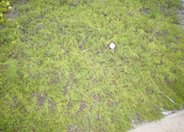
Common name:Blue Elderberry
Botanical name:Sambucus mexicana
The Blue Elderberry is a deciduous shrub that grows 4'-10' tall or tree that reaches up to 40' high. The leaves of this plant have 5-9 leaflets with white spring flower clusters developing into blue berries. The Blue Elderberry is a native to California, is drought tolerant and is a beneficial insect plant.
-Cornflower Farms

Common name:Purple or Gray Sage
Botanical name:Salvia leucophylla
The Purple Sage is an evergreen shrub that grows 2'-3' tall and 5'-6' wide. It has white stems and leaves and light purple flowers that bloom between May and June. This shrub tolerates heat and drought. The Purple Sage is a California native.

Common name:California Poppy, Golden Poppy
Botanical name:Eschscholzia californica
This small annual (sometimes acts as a perennial) plant will grow to less than 1' tall and has light, small blue green leaves with gold and orange flowers that bloom in spring and summer.

Common name:Dwarf Coyote Brush or Chaparral Bro
Botanical name:Baccharis piluraris 'Twin Peaks'
Complete with a strong, dense root system which clings attractively to slopes, this makes for an excellent low maintenance ground cover. In addition, it has no messy seeds.

Common name:White Alder, Western Alder
Botanical name:Alnus rhombifolia
White Alder is a deciduous tree with spreading or ascending branches and downward pointing tips. It has coarse teeth and dark green leaves. It is very fast growing 50'-90' tall with a 40' spread. It is very heat and wind tolerant and is a native to California. Green yellow flowers appear in spring. During winter, small cones decorate bare limbs.

Common name:Catmint
Botanical name:Nepeta X faassenii
Nepeta faassenii makes soft, gray green, undulating mounds that are 1.5' high when blooming. The small leaves are attractive to cats. This perennial has lavender blue flowers in late spring and early summer.

Common name:Island Bush Snapdragon
Botanical name:Galvezia speciosa
Island Snapdragon is an evergreen shrub or vine that grows from 2'-3' high and 3'-5' across with red spring and summer flowers. This plants needs partial shade in hot inland areas. It is a California native that is drought tolerant. It attracts hummingbirds. - Cornflower Farms
| Designer: Unknown | Wildlife Habitat Garden 17 |
Photographer: GardenSoft |
Soils and Compost:
Incorporate compost 6" into your soil to retain water, reduce compaction, feed earthworms, and provide valuable nutrients to your plants.
Water Saving Tip:
Mulching and adding compost to soil can minimize evaporation and help soil absorb and store water.
Integrated Pest Management:
Attract, or buy beneficial insects such as ladybugs and lacewings to control pest outbreaks in your garden.
